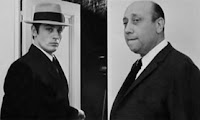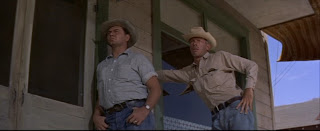My Darling Clementine Directed by John Ford
 |
| John Ford on location |
I grew up on westerns.
I watched Gunsmoke with my Grandparents on their black & white TV,
then we watched Bonanza in living color.
The very first movie I saw on the big screen and it was a huge screen! A drive-in,
was a western
Although to be fair I don’t remember the movie, since I was 7 and I fell asleep after the popcorn was gone.
But since then I have watched 100s of westerns,
old ones, new ones, silent ones, loud ones,
ones in black & White, and ones in CinemaScope.
I’ve watched the lone wolf, and the Calvary to the rescue.
I believe the Western is America’s Magnum opus, and John Ford is her Michelangelo.
 |
| John Ford |
John Ford, grew up about as far away from the wild
west as one can ( in Maine) and still be in the Continental U.S. and he was born when the U.S. still had some wild frontier with Arizona, Utah, New Mexico, and Oklahoma still territories.
 |
| Early days of Hollywood |
After finishing high school he skipped the west and went to the Wild Wild World of Hollywood were his brother Francis was already working for Universal.
Ford started at the bottom working at any job he could get in the business; as a carpenter, a prop man and a part time stunt man and an actor.
He appeared as a Klansman in D.W. Griffith’s Birth of a Nation.
Within three- years of arriving in Hollywood,
Ford was directing films for Universal then for Fox Studio.
By he won his first Academy award for best director in 1935 for The Informer
Ford had directed over 85 films!
In the next 10 years Ford would direct, Stagecoach, Young Mr. Lincoln, The Grapes of Wrath, How Green Was My Valley and he finished out that 10 year period with My Darling Clementine
Ford made many films outside of the western genre, but even those films, covered the same ground.
He had a vision and a style that is American, it may be a mythical America, but its uniquely Red White and Blue,
NAY-sayers believe his tales simple, and unimaginative,
but they mistook simple for simplistic, and they are just plain wrong about unimaginative.
Ford was a master storyteller, a folk artist, with an amazing eye for detail, and a wire walker's sense of timing.
His use and placement of the camera is always spot on and as good as any other director past or present. His use of the long swiping shot, usually with a lone rider or a few against a massive earthscape is what all epics have tried to duplicate.
The best comment I can bestow o Ford
is quoting Orson Welles:
“ I learned from the old masters,John Ford, John Ford and John Ford”
As a storyteller Ford had many themes, messages, and one for which he does not get enough credit, was his value of the group, the strength of families, and of comrades, and the bond of soldiery. This theme is in almost every one of his films, western or non-western.
This theme of group, is a smack down of the the loner myth, which is the theme of tons of westerns; of the loner saving the day,
and most of those films- I said most- dont stack up to John Ford's worst films.
Ford understood the settling of a nation isn’t done by the one but by the many. It may not be fair, in fact it maybe horrible, but its the building of a nation and its people.
Ford also had a loyalty to a group of actors and places,
in My Darling Clementine, you see several actors in supporting roles that appear in many of Ford’s films, but maybe his biggest Co-star in this film, was
 |
| Monument Valley |
Monument Valley, is a gorgeous area on the Arizona-Utah border, that is part of the Navajo nation.
A bit of trivia - Ford used Monument Valley in eight of his films.
Ford was not immune to the stereotypes of the time, and he used clichés about Native America’s and Mexicans in some of his films.
BUT many of his best films, raised the top of some of those stereotypes and almost all of his films that carried storylines with Native America’s dealt with them as honest as he could for his time.
BUT there is no doubt that he didn’t exploit them financial, he paid the Navajo nation well for the location and hired locals both for behind the scenes work and in front of the camera. Later in his life he was made an honorary member of the Navajo nation.
The newest DVD edition of My Darling Clementine contains a preview version that Ford showed to the Film's producer Darryl Zanuck. Zanuck made some changes cutting out almost 30 minutes and adding a couple of additional scenes, the additional footage was shot by a solid director in his own right-Loyd Bacon Zanuck's version is the version that has been showing on TV and revivial houses for years.
- according to the bonus features on the dvd- which if you have a chance watch you should, the guy who put together the newest print talks about the chances that Zanuck made and its worth your time.
I've added a few minutes from the bonus feature on the video exhibit linked below,
please check that out
 |
| Victor Mature as Doc Holiday |
But whichever edition you watch it's still a American masterpiece
A note-
I’m 49 going on a 100, and as I said earlier,
I enjoy westerns, but over the past decade when talking with the 30 and under crowd, a lot of those guys and its guys, - over the years, I've found that very few women, I talk too like westerns-
So the guys I chat with who love action films, just don’t seem to care for the western,
and I think part of the reason for that maybe video games.
They grew up playing video games with monsters, Nazis, zombies, or pro athletics.
Very few play a western type game, plenty of war games, crime shoot-em ups, but no westerns or at least not many.
My unscientific research came up with 3 western style video games, released in the last 2 years and none of them seem to be big sellers.
My guess -again I could be talkin out my backside, since the last video game I played was pong.-
But my guess is the west seems to slow, it seems tobe of your granddad’s generation to be cool for this generation.
but their wrong!
I think the west is way cool!
And I bet my 10 gallon hat it won’t be riding into the sunset anytime soon.










































